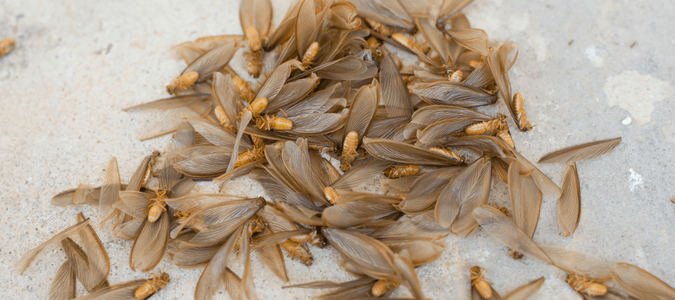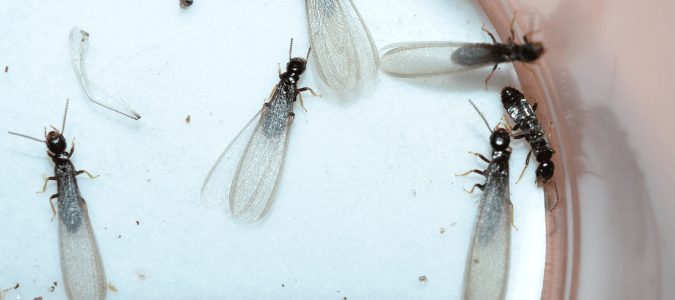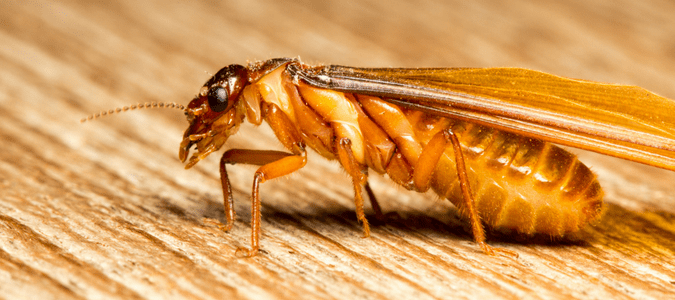Have you ever wondered why flying termites are more likely to make an appearance after it rains? Homeowners often wonder what this means and what they need to do.
There are a number of factors that influence when termites swarm, including humidity and warmth. Right after a spring rainstorm, the environment is perfect for flying termites to leave the nest and find a mate so they can start a new colony.
Unfortunately, spotting flying termites is an indication that there is already a large termite colony nearby. You should not take this lightly since termites can cause severe structural damage.
There are several species of flying termites, and they can be a variety of colors, including black flying termites. While these pests do not bite, they can cause damage to your home.
Why Are There Flying Termites After Rain?
Rain can stimulate termite activity, so it’s normal to see these pests after rainfall. However, some termites can fly while others cannot. Termites that have wings are swarmer termites, whereas termites without wings are typically worker or soldier termites. It’s worth knowing though that swarmers drop their wings after mating.
Worker and soldier termites spend their lives hidden in their nests, but swarmer termites have a different responsibility since they are the only termites that reproduce. In the springtime, swarmer termites leave their colony to mate and find a new nesting spot so that they can start new colonies.
Homeowners often see swarmer termites on their walls, windowsills and inside of light fixtures. They are often mistaken for flying ants; however, flying termites have larger and more uniform wings.
Once they mate, they drop their wings and look for a nesting place, so it’s also normal to see discarded wings around your home.
If you find flying swarmer termites in your home, it is a sign that there is an active termite colony taking up residence somewhere nearby. Do not take the sight of flying termites lightly since they often point to a much larger problem.
How To Deter Termites
The first step in deterring these pests is determining how termites get in your house. These pests feed on cellulose which can be found in wood, insulation, cardboard and sheetrock. Subterranean termites need moisture to survive and they prefer moist, easy-to-chew-through items containing cellulose, so eliminating sources of excess moisture in your yard can help make your yard less hospitable.
Make sure your gutters point away from your foundation and keep an eye out for leaky pipes, faucets and air conditioning units. If you water your lawn with a sprinkler system, limit how often it points towards your house. You should also keep firewood away from the side of your home since it’s a common hiding place for termites. They can easily travel from the firewood into cracks in your home’s exterior to invade the interior.
The best way to deter termites is to work with an expert pest control specialist. They can inspect your home and provide scientifically proven ways to keep termites away. If you are already dealing with a termite infestation, they can also treat your home with effective solutions.
What Are Black Flying Termites?
When you visualize termites, you probably think about tan-colored pests. However, termites can be a variety of colors, especially swarmer termites with wings. Flying termites can be tan, dark brown or black, depending on their species.
Black flying termites are Eastern subterranean termites and they are found all over the United States. Eastern subterranean swarmer termites can have black bodies that are between one-fourth and one-half of an inch, which is longer than worker or soldier termites from their species. Worker and soldier subterranean termites are usually cream-colored.
Eastern subterranean swarmer termites also have long wings that are a translucent milky color. They actually have two pairs of wings, making a total of four, but the pairs are uniform. Since the wing pairs measure about the same length, it is hard to tell them apart. At rest, the wings stick out backward past the swarmer termite’s body.
Black flying termites are often mistaken for flying ants since they are a similar color. However, some key differences can help you distinguish them from each other.
First, while flying ants also have two pairs of wings, they are not uniform like flying termites. Their front pair is noticeably longer than their back pair, which makes it easier to see both pairs. Additionally, flying termite wings, which measure twice the length of their bodies, are much longer in comparison to their body than flying ant wings.
Flying ant antennae also have an elbow curve to them, whereas flying termite antennas are completely straight. The body shapes of these two insects are also different. Ant bodies appear more segmented because they have thin waists. Flying termite bodies are more uniform.
Even with all these distinctions, it is hard to tell flying termites and flying ants apart because they are so small. If you see a black flying bug in your home and aren’t sure what kind of pest it is, call a pest control expert to help you identify it.
Termites, especially subterranean species, can cause severe and costly structural damage to homes. It’s wise to control the infestation as soon as you can. Contact a professional pest control service for termite control.
Do Flying Termites Bite?
Anytime homeowners see flying insects in their homes, it’s normal to wonder if they bite or are dangerous. When it comes to flying termites, it can be especially confusing since they are easily mistaken for flying ants.
The good news is that flying termites do not bite. However, that does not mean they don’t pose a threat when found in your home.
Unlike worker termites, flying termites do not eat through wood. Although they are not actively causing structural damage to your home, they play a vital role in the process. Flying termites leave their colonies when their nest reaches maturity. That means that seeing a swarm of flying termites indicates that there is already a large colony nearby.
After leaving their nests, flying termites can mate and start new colonies elsewhere in your home, which can lead to more damage. As the only type of termite to reproduce, flying termites make it possible for termites to cause costly damage.
Excess moisture around your home can lead to the presence of termites. Keeping an eye out for damp wood around your home’s exterior can help you catch a problem early or prevent a future problem.
Again, flying termites are not the ones chewing through wood, but their activity leads to more worker termites destroying your home. Even though flying termites do not bite, you should not treat them like harmless pests.
Contact a pest control professional when you notice flying termites or signs of termites in the house, such as discarded wings. Do not wait to kick them out of your house before they cause more damage.
Tackling Flying Termites
As a homeowner, seeing a pest in your home always raises questions. When it comes to flying termites, homeowners want to know how threatening they are and what it means to see them after it rains.
If you see flying termites, you should contact a professional pest control service. They will identify where the termite colony is hiding, inspect the damage and get rid of these pests.
ABC Can Treat the Termites on Your Property
Finding termites on your property can be extremely frightening. These pests are destructive and their colonies can hold one million members or more. If you believe you have termites on your property, contact ABC Home & Commercial Services. Our professionals will be able to locate the termite colony and then implement an effective pest control plan. Whether you have drywood or subterranean termites, we can help,



